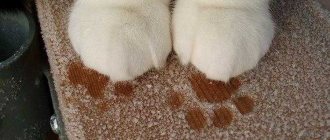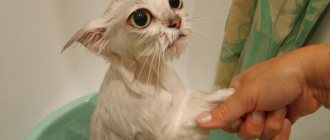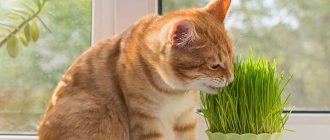Caring for kittens from birth to 4–5 weeks (1–2 months)
At 4–5 weeks of age, kittens are especially defenseless and vulnerable. Newborns are looked after by a mother cat, so the person’s task at this stage is to arrange a box or cage in a secluded corner and not separate the kittens from their mother. The owner must monitor the well-being of the cat and its children and, if necessary, call a veterinarian.
The most important thing is to watch how the kitten sucks its mother’s nipple. At this age, kittens that cannot suckle die of hunger. To check whether the baby is eating well, you need to weigh each kitten every morning and evening and write down the results in a notebook. Weight control will help you find out which of the kids is not eating enough and who needs help. Every day the kitten should gain 5–15 grams in weight.
It is very important that kittens sleep well the rest of the time. If your baby starts squeaking between meals, it means he's hungry.
Note! Weak pets do not have enough strength to squeak. Therefore, it is necessary to monitor, first of all, weight gain.
Signs of good nutrition:
- the baby is steadily gaining weight;
- The kitten sleeps soundly in between feedings.
About a week after birth, it becomes noticeable that some kittens are very active and eat well, while others are weaker and eat poorly. It is necessary to closely monitor the well-being of weak children. As a rule, strong children choose the best pacifiers. In order for weak kittens to receive a sufficient amount of mother's milk, they need to be brought to the best nipples.
Scottish Fold
The owner's help will be needed if the cat's milk runs out or she refuses to feed her babies. Then the person will have to feed the newborns himself.
A cat may refuse to feed its children in 2 cases:
- Hormonal imbalance - often associated with too early birth before the age of 10 months. The health of a small cat may not withstand heavy stress.
- Eclampsia during childbirth is very common. For prevention, you need to give your cat intramuscular injections of calcium gluconate from the very first weeks of pregnancy: 1 cube once a week. Instead of injections, you can give Osteogenon: one quarter of a tablet every 2 days.
After giving birth, the mother can be given Caforsen injections: once every 24 hours, 0.1 ml per 1 kg of cat’s weight.
Caring for a kitten at the age of 2 months is less difficult. Two-month-old babies can gradually try solid food. Once kittens reach 8–10 weeks of age, they should learn to eat dry and wet food. You need to consult a veterinarian and offer your babies premium food designed for this age. In addition, older kittens need to be trained to use a litter tray.
Children should not be separated from each other
Heating
Heat exchange processes in the body of newborn kittens are not entirely complete, since the organs and systems have not yet fully formed. Therefore, at first they really need maternal warmth. But what if for some reason the kids are left without a caring cat? These functions are performed by a person:
- The air temperature in the room should be raised.
- You need to line the box or bed with warm woolen cloth, wrapping the newborn kittens.
It is important for the owner to know that normally in healthy kittens the body temperature should vary from +37.2° to +39.4°C.
Also watch the video of a cat raising kittens:
How do pets take care of their offspring?
Without a doubt, there is a big difference in the way domestic and wild animals take care of their babies. After all, a person looks after the family, feeds them and protects them. But the predators are left to their own devices.
This topic is discussed in the 3rd grade in the world around us and children even make thematic drawings and presentations. Well, if we consider how pets take care of their offspring, then we can identify several main signs.
It is important that after the birth of the baby, the mother feels safer, since there is a familiar environment at home. But, truth be told, most often she still won’t let a person near her offspring.
Although there are exceptions, when such a close connection is established between them that a pet can give a person its newborn children. This is more common in dogs and cats.
Every mother naturally feeds her child with her milk. This is the safest food for a newborn baby.
Also, until the cub is strong enough, the mother licks its fur with her tongue so that it is clean and does not pick up any infection due to dirty fur.
Mothers always sleep with their children in order to protect them from potential danger all day and night.
You can often see new parents playing with their children. Games are often educational in nature.
For example, children are taught to hunt. Yes, even domestic cats or dogs should be able to hunt, because this is one of their basic instincts.
If we talk about feeding, then those animals who live in our apartments simply show the children where the bowls with food and clean water are. Often they simply follow their parents, and then independently find food based on a familiar smell.
The same applies to the toilet. So the kittens watch their parents go to the litter box and simply repeat this action after them. After all, this is how it is supposed to be in their cat family.
Adult dogs on the street teach kids to observe hygiene standards. And often, then at home, endure water procedures in the form of washing paws and tummies.
If we talk about large domestic animals - cows, goats, and so on, then they show calves and kids how to pluck grass correctly and which plants are suitable for food and which are better to avoid, thus introducing them to the world around them.
Also, by the example of their parents, the cubs learn to trust a person and see him as their friend. Large animals also wash their children with their tongues, show them a place to sleep and where they can always find hay and clean water.
We can say that almost all animals take care of their offspring according to one standard scheme, which really works and allows you to raise healthy offspring, which then are well oriented in the world around them.
Why don't some cats accept kittens?
There are a number of reasons why a female mother ignores her newborns. They may be behavioral, caused in part by hormonal imbalances. Sometimes a cat will not accept kittens due to a medical condition that makes her unwilling or unable to care for her children.
Behavioral problems
Some mother cats believe that the first kitten born is the only one. They focus on him and ignore others. Sometimes a female rejects a litter born by Caesarean section, as well as due to undeveloped maternal instinct.
How do animals take care of their offspring?
Many of you have seen how cats and dogs take care of their children. Cat cubs are born small and helpless. In the first days after birth, they do not see or hear anything - they only squeak thinly and plaintively and crawl on their tummy. Immediately after the babies are born, the mother cat licks them thoroughly. The mother cat feeds them milk and fiercely protects them.
Sometimes cats adopt cubs and other animals.
Mother dogs also carefully take care of their cubs until they become completely independent. They warm newborn babies with their bodies and almost never leave their side. They feed with their own milk. Protect from enemies.
When the puppies grow up, the mother teaches them the techniques of fighting, hunting, and behavior in dog society. Their father often takes part in raising older puppies.
Cows, goats, chickens, ducks, geese and other domestic animals and birds also take care of their young.
What about wild animals? Do they take care of their young? Certainly! Perhaps even more selflessly than those at home. After all, wild animals are not under the care and protection of humans.
For example, elephants. They usually live in a herd - a mother elephant, her daughters of different ages and baby sons. A mother elephant feeds her babies milk after birth for about two years. When a herd of elephants moves to a new place, the baby elephant holds onto the tail of its mother or older sister with its trunk.
Well, if the baby elephants are in danger, the elephant fiercely protects her children, and then she is very aggressive. When attacking an enemy, the elephant hits him not only with her tusks, but also with her trunk.
The wild relatives of cats, tigresses, are also very caring.
A mother tiger feeds her little tiger cubs with milk for up to six months, even though after two months they are quite capable of eating meat. And then the tigress begins to patiently teach the kids the wisdom of hunting.
Bears are also very caring and patient mothers. They spend a whole month constantly next to the newborn cubs, feeding them milk. And when babies have baby teeth, they allow the cubs to feast on berries and insects.
The mother bear teaches mature cubs how to hunt, climb trees, and swim. Often, cubs climb on their mother, bite, and pull the tail and paws. Usually the bear tolerates the pranks of the kids. But he may growl angrily at an overly naughty bear cub, or even give him a hard slap with his paw.
How do monkeys take care of their babies?
Monkey mothers do not leave their babies alone. They carry them with them everywhere. Baby monkeys are always kept clean - the parent monkeys monitor this very carefully. They lick the fur and catch insects. And even grown-up monkeys, having quarreled with their relatives, resort to their mothers for sympathy and consolation.
Marine mammals also take care of their babies.
From morning to evening, birds fly in search of food for their chicks. For example, a swallow can fly to a nest with food four hundred times in a day! And the birds teach the grown chicks to fly.
How do waterfowl, such as ducks, take care of their chicks?
The duck does not have to feed the chicks herself. As soon as the chicks are born, the mother duck leads them to the water. She teaches the chicks how to get food. At the same time, the duck carefully monitors their safety, diligently hides the ducklings in the reeds, and warms them under its wings. There, under the wings of the mother duck, the downy outfits of the chicks are lubricated with fat. Without it, the chicks' down will get wet, and the chicks will not be able to swim.
You can often hear that the cuckoo is a bad mother. She throws her eggs into other people's nests. In fact, there are more than one hundred and fifty species of cuckoos, and most build their own nests, hatch their eggs, and feed their chicks.
Insects also take care of their offspring. Everyone knows how much care ants and bees take for their larvae. But other insects lay eggs only where their larvae can find food.
Some species of fish are also caring parents. There are fish that build nests to protect their eggs or fry. For example, macropods and gourami build foam nests.
But seahorses not only carry their offspring in a special bag, but also look after them after birth and share nutrients with the babies.
We can talk endlessly about how animals care for their offspring. And if the children find it interesting, they will be able to learn even more from books, magazines, and the Internet.
https://www.bolshoyvopros.ru/questions/2279874-kak-narisovat-risunok-kak-domashnie-zhivotnye-zabotjatsja-o-svoem-potomstve.htmlhttps://ecologyproblems.ru/interesnye-fakty-o-zhivotnykh/ 459-kak-zabotyatsya-o-svoem-potomstve-koshkihttps://videouroki.net/blog/kak-zhivotnyie-zabotiatsia-o-svoiom-potomstvie.html
How a cat trains kittens
As soon as the kids get a little stronger and get used to the new world, the cat begins to train them. Learning begins with the simplest things - how to distinguish one’s friend from another’s, how to move, how to behave in different situations. Mom is an undeniable authority for kittens; it is from her example that they learn everything. By the fifth week of life, the cat teaches the kittens hygiene, to eat carefully and wash their faces after eating. At the age of about a month, the mother begins to take the children for walks, and then teaches them to climb, jump and hunt. It is at this moment that babies are most often separated from their mother, although this is not entirely true. In order for the kitten to develop mentally and physically, it is worth leaving it under the care of its mother for at least two to three months. At the age of three months, babies are already fully trained in the rules of hygiene, behavior, and even know how to hunt a little.
The process of raising and raising kittens is a troublesome and time-consuming task. But any female copes with this task wonderfully thanks to her instincts. All that remains is not to interfere with her, to intervene only in the most extreme case - if the mother or baby is ill.
Similar articles:
- Adopt a cat from a shelter
- Why do cats kill kittens?
- How cats predict the weather
- Why do cats eat grass?
- Large breeds of domestic cats
- Why does a cat need a tail?
Kitten health
Once you get a kitten, start listening to word of mouth
After all, it is very important to find YOUR veterinarian! Based on the advice of friends or reviews on the Internet, it will not be difficult for you to do this. At your first meeting, ask your future family doctor about nutritional recommendations, options for fighting parasites, the first signs of disease, and get a schedule of vaccinations and visits to the veterinarian
Deworming a kitten
About 7 days before the first vaccination you need to do deworming. Subsequently, kittens undergo this procedure every three months until one year. It is optimal to use broad-spectrum drugs for the prevention of parasites.
Flea control
Fleas are no joke. It’s especially not funny for the little ones who have these parasites. They cause itching, allergies, dermatitis, lead to exhaustion and the development of blood diseases! Have we scared you? Anti-flea products come in five types: drops, sprays, shampoos, collars, tablets. Do not rely on your choice if your pet is still very young, but consult your veterinarian.
Vaccination
IMPORTANT! It is necessary to vaccinate both animals that live in the yard and those that do not leave the apartment. Both the first and second can get sick equally, so it’s better to be safe
Kittens are vaccinated for the first time at the age of 8-9 weeks. In this case, vaccinations that do not contain the rabies virus are used.
Revaccination is carried out when the kitten is 12 weeks old. This complex vaccine already contains the rabies virus.
The next revaccination takes place once a year and then once every year.
The scheme may change slightly. Your veterinarian will suggest the best one.
Sterilization/castration of an animal
If you are ready for the fact that the kitten, as it grows up, will begin to “mark” its territory, demand a cat (cat) and regularly “bring it in,” then you don’t have to read any further. If this prospect does not make you happy, then let sterilization/castration be the most humane way to solve many future problems.
It is best to castrate a kitten at the age of 9-10 months.
A cat needs to be spayed before its first heat, which is approximately 8 months of age.
To conclude this chapter, we will tell you about the signs that mean your cat is having health problems.
So, what should you always pay attention to? Reasons to contact a veterinarian include: poor appetite, poor weight gain in the kitten, vomiting, bloating, diarrhea, runny eyes, pale gums, cough or shortness of breath, nasal discharge, difficulty urinating
At first glance, it seems that keeping a kitten is very, very difficult. In fact, this is a very pleasant thing, because the word “content”, if you regularly follow all our recommendations, will disappear from your diet and they will become just a way of life. And, believe me, when the fluffy ball settles on your lap and starts his endless “Purrrrrrr”, you will say that it was worth it!
We recommend reading very good books:
- Lyudmila Antonova “Care for domestic cats”;
- Elena Filipova “From a cat’s point of view.”
Dream Interpretation - Cat, cat
You have a hidden and very cunning enemy who is harming you on the sly. Black cat - be careful when communicating with strangers. Scratched or bitten you - you will be subjected to slander. Beautiful, pure - an insidious seductress will stand in your way. With kittens - an attempt to weaken your peace of mind through humiliation of your loved ones. Kill - the vile and insidious plans of your enemies will destroy you. To be caught is selfless service to someone to the detriment of oneself. Attacks - expect enemies to attack soon. Washing - the resulting calm is temporary, this is the calm before the storm. Hearing meowing means you will be drawn into an unpleasant situation due to the unworthy behavior of people unfamiliar to you. Purrs and caresses - an enemy is hiding under the guise of a friend. Play - you will become a victim of other people's intrigues. Crosses the road - competitors will be able to deprive you of the income you were counting on. A cat in a bag or basket is a betrayal of a loved one. Pulling by the tail - you will be drawn into an illegal matter
Catches a mouse - enemies will take advantage of your carelessness. Climbing a tree - an ill-wisher among high-ranking people
Cats are fighting - a series of minor troubles and quarrels awaits you. Imagine that you are unleashing a pack of huge dogs on a cat (see Dog).
Meeting the enemy
In birds that nest in colonies, the survival rate of offspring is high, since enemies do not dare to attack a large flock. Seagulls are quite capable of coping with large predators and even humans.
Collared peccaries live in large herds consisting of individual families. A peccary family usually consists of one male and three females with cubs. When an enemy, such as a jaguar, approaches, the males distract him, and the rest of the family takes flight.
When cheetahs sense that their cubs are in danger, they carry them, one by one, to safety, holding them firmly but gently by the scruff of the neck. The cubs do not resist and patiently endure such a “transfer.” The female hamster carries her babies in her cheek pouches or in the enlarged space between her teeth.
Many birds try to distract the enemy from the nest by pretending to be wounded. They sacrifice themselves for the sake of the chicks. A pair of waders take turns guarding the nest - both father and mother pretend to be wounded.
Kitten adaptation
The optimal age to adopt a kitten is 3 months. His immune system has already strengthened, his intelligence is developing, and his appearance is also visible.
How to make your baby accept your home as his own? Be prepared to help him with this for the first 3-4 weeks.
On the first day the kitten is in the house, limit its space to one room. Let him look around, sniff, and only then introduce him to the rest of the territory.
Playing with a kitten
Kittens develop better in games; they perceive their playmate as their friend, so don’t be lazy to spend 15-30 minutes every day playing with your baby. Some kittens are even better trained after this. Kids who were played with as children are more cheerful than kids who were not paid attention to.
Friendship with a dog or another adult cat
First, the animals need to be introduced. The advantage of a kitten is that it smells like childhood and an adult animal will sooner or later accept it anyway. During the first meeting, avoid direct contact. Lock the animals in different rooms, and then switch places. This way they will get used to each other's smells.
Afterwards, arrange a “confrontation” again. If there is no conflict, then consider that friendship will definitely happen.
Kitten and child
A child who is too young may inadvertently hurt the kitten. Therefore, contact should take place under the supervision of an adult. Older children need to be explained the rules of playing with a kitten. By the way, the latter must also feel the limits of what is permissible.
Read: The best cat breeds for a family with a child.
Conan the Barbarian or Destroyer Kitten
“A cat knows how to purr himself and forgive himself for anything.” However, the destruction that the baby causes is not small at all. To prevent damage, you can cover the furniture with double-sided adhesive tape, place valuable items at a height inaccessible to the baby, and remove flowers and photo frames higher up.
Limit the kitten's passage to hard-to-reach places and, as an alternative to trimming the claws, put special tips on the claws.
Tray training
There is a kitten in the house, how to care for it - we teach it to the litter box from the first days. In this case, many breeders recommend placing the kitten with a litter box in which filler from its native litter box has been added in advance, so to speak for smell - so to speak, the familiar smell will tell you where and what to do. Don't worry if your baby doesn't go where you want from the first row - he'll definitely do everything right in the next row.
You can't fool nature
The first few hours of a kitten’s life can be a harsh and very difficult time for them - an inexperienced first-time mother rejects one or more babies. The poor fellows need assistance: delicately teach the cat to care for newborns and feed them. Along the way, another problem may arise - in the first 24 hours after birth, due to hormonal imbalance, the cat sometimes lacks milk, and then there is a possibility that the mother will ignore her offspring. The use of hormonal drugs that stimulate lactation solves the problem. The cat produces milk and accepts the babies.
Natural instincts make themselves felt when a cat rejects or completely throws out a sick or weakened kitten from the nest, believing that it will not survive. In this way, the mother tries to mobilize and devote all her strength to feeding healthy kittens. You can try to help the unfortunate person by providing the necessary treatment and providing him with artificial feeding. The cat usually willingly accepts the baby back, recovered and stronger.
When artificially feeding kittens you will need:
- special industrial mixture (detailed instructions for use will be indicated on the packaging);
- pipette, syringe without a needle or bottle (depending on the age of the kittens);
- measuring cup.
Dishes should be thoroughly sterilized before each use. When feeding, place the kitten so that the back is up and the head is not thrown back. Try not to let air get into your stomach with the milk. Avoid using too much formula, which could cause your baby to choke. Don't force feed. It is better to reduce the time between meals and reduce the dosage. If the cat is not able to not only feed, but also care for the litter, then the elimination reflex in the babies should be stimulated after feeding. To do this, after saturating the kitten, massage its genitals and anus with a damp swab, as if repeating the movements of the cat’s tongue.
Cats are vulnerable creatures
Unlike dogs, whose devotion is clearly demonstrated, cats do not express emotional attachment to their owner. But their independence is illusory: when separated from their owner, cats can experience extreme stress. Almost any change can affect a cat’s mental state: the arrival of a child or a new pet in the house, moving, or even simply the disappearance of an old chair.
At moments when something changes in the cat’s environment, it is important to be close to her and surround her with affection. This way the cat will feel that everything is okay. Also, under no circumstances should a cat be beaten or humiliated. This is unacceptable and, most importantly, completely useless: the cat will not become obedient, but it can harbor a grudge and take revenge on the owner for a long time, for example, spoiling his favorite things. For a cat, the owner is not only a leader, but also a friend.
Caring parents
In many species, raising offspring is a purely male endeavor. The female South American Darwin's rhinoderma frog lays 20-40 eggs on the ground, leaving them in the care of the male, who stores them in his mouth. The tadpoles, hatched from the eggs, live in the male's mouth until they reach a centimeter in length and their tails begin to shorten. Then the father releases the tadpoles into the water, where the cubs further develop.
The male stickleback builds a nest of plants at the bottom and invites the female to it so that she can lay eggs there. The male then fertilizes the eggs and protects them, using his fins to create a constant flow of water. He also takes care of the fry until they grow up and fly away in different directions.
Other inhabitants of the aquatic expanses, male seahorses, play the role of father even more exemplarily. They have a special cavity on their belly, into which the female lays about fifty eggs. The male fertilizes them and carries them in a pouch until the eggs hatch into fry. The embryos in the bag are fed with a special nutrient liquid. Newborn seahorse fry leave their parent's pouch and immediately swim off to sea.
How to care for a kitten at home
The decision to adopt a kitten involves not only having fun with your pet, but also caring for it properly. The most difficult period of nursing occurs in the first six months, when the little animal understands the world and acquires important skills. We need to figure out how to care for a kitten depending on its age, condition, and what needs to be purchased so that all family members feel comfortable.
Caring for newborn kittens
A cat's maternal instinct is manifested by caring for her offspring, but after giving birth she needs to restore her health in order to feed her children. A person’s task is to provide good nutrition and comfortable living conditions. Newborn blind kittens need a warm place, a dry bed, low lighting (darkness), and the absence of irritants. The mother will give the rest. You should not touch the babies or pick them up - the cat may not like the foreign smells and will refuse the babies.
1 month
Caring for a one-month-old kitten, which is weak and helpless, eats only dairy food, needs care and affection, takes a lot of time:
- Get used to eating from a bowl (4-5 times a day), supplement with a syringe. Overeating leads to regurgitation, diarrhea, and bloating.
- If you plan to switch to ready-made food, complementary feeding should be started with them; dry foods should be pre-soaked. Homemade menu consists of chopped products or ready-made baby food.
- For the toilet, choose wood litter or use disposable diapers, teach your pet to use it immediately after eating, but it is not recommended to poke his nose into a puddle often. Trays with bars do not require filler, although they must be washed several times a day.
- There is no need to bathe the baby, but it is necessary to take care of the ears and wash the eyes with boiled water or special drops.
- An animal brought “from the street” is indicated for deworming.
2 months
- The diet is replenished with permitted products. Whole milk, potatoes, pasta, salted, smoked, spicy foods are excluded.
- Buy ready-made food “For kittens”, do not use canned or too cheap ones. Soak dry pieces.
- Toilet training should begin from the first day of life in a new place.
- Rinsing the eyes is carried out with a napkin moistened with boric acid, furatsilin solution (outside to the nose), and chamomile decoction.
- Once a month, clean your ears with a cotton swab lubricated with oil or cosmetic Vaseline. This is also done to prevent ticks. 2 months is the period for the first vaccination.
- Begin nail training and trim the nails a little. Brush the coat regularly.
- Carry out the first water procedures. Water temperature – no more than 38 degrees. Do not wet your head, ears or eyes.
- Provide toys.
3 months
The three-month-old kitten has all its teeth, it sees and smells well, eats adult food, explores the world around it, and plays. The baby is able to live without his mother, but not without the help of the person he is used to. The owner takes care of the pet, corrects behavior, and develops skills. Feed on time and correctly, carry out hygiene procedures, vaccinate, ensure safety - these are the main tasks of maintenance and education.
When can you take kittens away from your cat?
How to properly care for a dog at home
Kittens can only be removed from their mother after they are 12 weeks old. It is necessary to prepare them for separation in advance. Kittens between 4 and 6 weeks of age should be picked up briefly and taken to another room where they will have their own bowls, litter trays and toys.
Note! To prevent the cat from missing the children after weaning, you need to remove all things that can retain the smell of kittens. Also, you should not wean all kittens at the same time.
If the kittens have lost their mother, a person will take care of the babies
Be healthy, kitty!
The unsatisfactory physical condition of the mother in labor is also one of the reasons leading to her rejection of kittens
It is important to determine what is bothering the cat and what is sick. Mastitis, eclampsia (milk fever), acute metritis and other complications, as well as various postpartum infections - this is not a complete list of possible ailments
Kittens in such a difficult situation are artificially fed, and their mother is treated.
Separately, we note that eclampsia can be triggered by poor nutrition of a pregnant cat and insufficient intake of vitamins and microelements into its body. To avoid unpleasant postpartum moments, you should take care of your pet’s health in advance, in particular, the composition of food and its quality.
Determining whether a cat has enough milk is not difficult. If newborn kittens gain weight, sleep well, do not squeak and look calm, then their mother has no problems with lactation. Otherwise, the babies will need to be fed additionally. Be sure to try to find a nurse cat for them - she will provide the brood with adequate nutrition
Your search was unsuccessful? No problem! By properly organizing artificial feeding, you can handle this important and responsible mission yourself.
What and how often should kittens be fed?
There are so many cat people, so many theories. Advice on the question “How to care for a kitten?” You will definitely be given a wide variety of tips, and not only by people you know, but also by strangers, you just have to go to a forum or website for cat lovers.
Specialized feed
There are dry and canned. Pros: caring for a kitten is simplified - no need to worry about cooking, food is specialized according to the age and breed of the cat (for kittens up to 4 months, from 4 to a year, from a year to 3 years, for long-haired, for short-haired, for the picky ones...) and contain a more or less balanced set of vitamins and microelements.
I’m not talking about Whiskas - if you have already decided to use artificial feeding, then take only top-class professional food!
If we talk about the downsides, tell me, what do you think first of all when you take a bag of “Chicken Stew with Rabbit” and read in tiny letters on the back that it contains only 10% meat? That's it!
In addition, cunning manufacturers add something to the food that makes the cat gobble it up on both cheeks, and indulge in meat only after a three-day hunger strike (the cheaper the food, the more pronounced this effect!).
However, some cat owners believe that there is simply no need to mix feeding regular food and specialized food.
But, in general, such food can become a “lifesaver” in case you are in a catastrophic hurry, and the cat is hungry...
Natural nutrition
A cat is a predatory animal. The basis of her diet should be meat food (and it is better to give meat more often than fish). A cat can also eat raw meat, but this carries the risk of infection with helminths, so it is better to boil meat and fish for both an adult cat and a kitten.
In addition to meat, the kitten's diet should include cereals (in the form of porridge, and not in the form of pasta or bread!) and vegetables, both raw and boiled (but not potatoes - starch is harmful to the cat's body!).
A good lunch dish for a kitten is finely chopped boiled meat in a 2/1 combination with porridge or finely chopped vegetables (beets, carrots, peppers, etc.). Oddly enough, not all cats like milk - it is better to give your kitten kefir or yogurt. It is also sometimes useful to give raw eggs (for kittens - yolks shaken in milk).
Yes, such care for a kitten will require more effort and time, but who can argue that naturalness is always better?
Feeding "from your own table"
Definitely the wrong way to care for a kitten!
Although very often you can hear conversations: “I have such a picky cat, he doesn’t eat anything but meat and fish!” - So you spoiled him, here is my soup, and borscht, and stew - everything that we ourselves eat! - Wow! Lucky! This is wrong!
For cats (especially kittens), everything salty, smoked, fatty, fried, sweet and floury is very harmful!
But, if you yourself are on a strict salt-free diet, you can treat your pet to vegetable soup without frying or steamed vegetables without oil.
Proponents of “one-pot” feeding make an argument: the animal itself will not eat anything harmful to itself. In nature - yes. A cat will not eat spoiled meat, will not chew a poisonous plant...
However, human cooking deceives natural instincts, just as we ourselves are not very capable of assessing the harm of a sausage roll or a cake with butter cream!
When caring for a kitten, you should remember that feedings should not be too abundant, but frequent: up to 2 months - 6 times a day, 2-4 months - 4 times, 4-6 months - 3 times, and an adult cat can be fed twice a day.
How to become an authority for a kitten?
A cat is not a pack animal, so building a relationship with it according to the classic hierarchical model, like with a dog, will not work. There is only one way to become an authority and a kind of leader for an animal: by showing it that obeying is beneficial. The pet must learn that a certain type of behavior is rewarded, while for other actions (attacking family members, damaging furniture, etc.) he will be scolded and punished, deprived of amenities and privileges.
Kitten care
A healthy cat has the right amount of milk for feeding, takes care of kitten hygiene, protects them from danger, develops natural instincts, gives lessons in adaptation to independent life, and fully provides care for them. If the mother is healthy, calm, and full of strength, people do not need to take additional care of the kittens. If she is weak, the responsibilities of feeding and raising fall on the shoulders of the owners.
Essentials
In order for an animal to grow safely, it is necessary to provide it with competent care. There is a list of things you need to get while waiting for a pet. This:
- Bowls for feeding and drinking - glass, metal, porcelain, earthenware.
- Toilet tray of the required size with a scoop for cleaning, filler.
- A bedding, basket, sleeping box or hammock that is secured in a warm, draft-free place.
- Cotton swabs, discs - for caring for eyes and ears.
- Scratching post - purchased or made from a piece of wood covered with carpet.
- A nail clipper with a limiter to cut off only the tips of the nails.
- Combs for wool, preferably metal, so that they don’t give you an electric shock.
- Zoo shampoo, towels.
- Toys - safe rubber balls, mice, plastic balls.
Nutrition
The cat feeds the babies for 30–40 days, but after 3 weeks they are fed milk from a nipple or accustomed to a saucer. Cereals, eggs, fish, meat, vegetables, cottage cheese are introduced gradually, and the required amount of water is given. The transition to dry and wet ready-made food should be made smooth. Kittens should eat little by little often, 5-6 times a day, to avoid bloating. Food should be at a pleasant temperature - cold will lead to indigestion and hypothermia.
When choosing ready-made food, you should take into account that economy-class products contain few useful substances, but there are plenty of flavors and preservatives. Such food provokes digestive problems and affects the quality of muscles, bones, and coat. Dry food of high-quality brands is balanced, but is suitable for pets only from two months of age. Their weak jaws chew mousses and meat purees better. Homemade food (boiled lean meat, fish, porridge, cottage cheese, vegetable additives) is good for a kitten. Prohibited:
- fried, smoked products;
- salted, pickled vegetables;
- sweets;
- baked goods, other flour products;
- food with spices, salt, seasonings.
Hygiene
A purebred or mongrel pet equally needs hygiene procedures
Timely litter box training is important. The filler should be of good quality
Do not use sand - it can become a source of infection and spread an unpleasant odor. The toilet must be systematically cleaned and washed.
Cats tear and scratch furniture because they need to wear their claws down. You need to shorten the kitten's claws at home with special scissors or tweezers or in a veterinary clinic. Purchasing a scratching post will make your pet’s life easier and save furniture
Washing should not be carried out more than once a month in order to preserve the sebum of a small pet: this is important for the condition of the skin and coat
How to feed newborn kittens if the cat has no milk
Cat owners are often faced with the need to care for newborn kittens if the cat has lost milk or if she refuses to feed the children. Newborns left on the street without their mother are in mortal danger. Every person should know how to care for a kitten at home. Caring for abandoned kittens is difficult, but pleasant: with proper care, the babies will grow up healthy and strong.
During feeding, the kitten should lie on its stomach - in this natural position it absorbs food well. If the sucking reflex is weak, you can hold the baby in an upright position. Placing it on its back is not recommended because the kitten may choke and suffocate. Milk should enter the baby's mouth gradually so that he does not choke.
You can feed babies with a syringe or bottle
How to feed cow's milk
It is highly undesirable to use cow's milk for feeding. Its composition is very different from that of cats. By feeding on cow's milk, the kitten will not receive many of the nutrients necessary for its development. In addition, the cat's body digests lactose very poorly. Such nutrition can lead to developmental disorders of the cardiovascular and nervous systems, digestive problems and other serious health problems in the baby. Some of the most dangerous complications are hypoglycemia, vitamin deficiency and rickets. An attack of hypoglycemia develops due to an acute lack of nutrients. To avoid this dangerous condition, it is better to feed with a special milk formula.
Note! To feed kittens, it is best to prepare a nutritional cocktail: 500 ml of cow's milk should be mixed with egg yolk and 4 tablespoons of sugar.
It is better to use goat's milk instead of cow's milk. It is mixed with water in a 1:1 ratio. The fat content of milk should be 10-11%, because cat milk has the same fat content. But even if the owner has no choice and has to feed the babies cow’s milk, you need to dilute it with warm boiled water: for 1 tablespoon of milk, about 3 tablespoons of water. It is most convenient to feed through a baby bottle with a nipple.
If a kitten is not gaining weight well (no more than 3 grams per day), it is necessary to give it an injection of vitamins - a “vitamin cocktail”.
How to cook:
- ascorbic acid - 0.5 ml;
- glucose 5% - 1 ml;
- sodium chloride (saline) - 3.5 ml.
Mix all components in a 5 ml syringe. Then inject 1 ml of liquid under the skin between the shoulder blades. This dose can neither be reduced nor increased. In the first case, the medicine will not work, and in the second, the kitten’s heart may fail. 1-3 minutes after the injection, the kitten begins to actively suck milk, and soon gains sufficient weight. If necessary, you can repeat the injection, but you need to do no more than 3 injections per day.
You need to set up a warm box or house for the cat and the kids.
How much milk to give a kitten at one time
It is advisable to feed from a baby bottle with measured division or from a syringe. This will make it easier to control the amount of milk. In the first 2 days, you need to give each kitten 1 ml per hour. Then daily the amount of food is increased by 0.5 ml. An older baby should receive 10 ml of milk per feeding.
If the kitten squeaks and does not let go of the bottle, then you can give him a supplement and increase the volume of milk until the baby has eaten his fill. A good appetite is a sign of health. However, you should also not overfeed, otherwise the baby will develop intestinal upset.
The milk should be warm, but not hot
Milk replacers for newborn kittens
Cat milk replacers are the best food for orphaned babies. You can find a variety of milk formulas for cats in pet stores and veterinary pharmacies. It is advisable to consult a veterinarian and choose a mixture in accordance with his recommendations.
Note! Milk formula purchased at a pet store should be diluted with boiled clean water and given to babies.
The best cat milk substitutes:
- Royal Canin Babycat Milk is a nutrient-rich formula that is easy to find in stores.
- Kittenmilch CdVet - contains not only milk, but also colostrum.
- Gimpet Cat-Milk - suitable for large breeds and even wild animals.
- Nutri-Vet Kitten Milk.
- Dolfos.
- Clauder's.
- Trixie.
- Hartz.
- Gimborn.
- Vo-Toys.
The most common is Beaphar Kitty Milk, but it is best to buy it as a last resort.
If you cannot find a suitable cat milk substitute, you can use Nestle Nestogen or Nestle NAN baby food with bifidobacteria. You cannot choose substitutes containing sugar.
After eating you need to massage your tummy
Milk replacer can be given not only to small but also to adult animals. This drink strengthens the body of pregnant, sick and weakened cats.
How to make milk substitute:
- Using a measuring spoon, add the required amount of dry milk mixture and pour in 3-5 tablespoons of boiled water. It is advisable to pass the water through a filter to remove scale from it. The drink should not be watery, otherwise the kitten will not receive enough nutrition.
- Mix thoroughly so that even the smallest lumps do not remain in the liquid.
- If necessary, heat to 37 degrees.
- The drink should be prepared only before feeding. You cannot store leftover mixture because it quickly deteriorates.
Cat breast milk contains docosahexaenoic acid (DHA). It ensures the baby’s development and health of the nervous system. This substance is included in many milk formulas, so before purchasing you need to carefully check the composition of the mixture. If the food causes an allergy in the kitten, you should consult a doctor so that he can recommend a suitable mixture.
It is better to feed with formula, but not with cow's milk
How long should you feed a kitten formula?
Kittens need to be fed formula milk until they are 2 months old. Starting from the fourth week of life, supplementary food should be gradually introduced into their diet: baby meat pates and purees (“Tyomu” or “Agushu”). After 2 months, you can give small pieces of boiled meat, a little cottage cheese and sour cream, as well as dry and wet food. Older cats can be offered a milk replacer as an addition to solid food. After 3 months, cats switch to an adult diet. If the kitten develops colic or other gastrointestinal problems, medication will be needed.
The diet is the same for all breeds: for British and Scottish Folds, for Maine Coons, Angoras and mongrel cats. It is important to remember that the shelter for small sphinxes must be well insulated.
Care in the first days of life will help kittens grow big and strong
Caring for a kitten is a painstaking and responsible, but at the same time very joyful job. Their health and life depend on the conditions in which newborns are kept. The efforts of the owners will be rewarded a hundredfold when the kids grow up strong and healthy.
We're already big
From the age of six months, teenage kittens begin puberty, and within a few months they become adults. Now they are independent and can separate from their mother. The cat treats the remaining individuals in the family differently. She is friendly towards females, but rejects males. This behavior is understandable and logical from the point of view of the laws of nature: “dislike” for a son prevents inbreeding. If the guy has nowhere to go due to, for example, limited space, the cat may change its position over time, which will most likely lead to inbreeding. What the new brood will be like, with or without anomalies, depends on the parents. Note that felinologists often cross close relatives in order to develop a new breed or to consolidate some desired characteristics. However, it is better for the average animal owner to prevent such a phenomenon, since its consequences can be extremely sad: the litter will end up with ugly and sick kittens.
Newborn needs
Newborn babies first of all need food. Quite interesting is the method of providing food to the larvae of Amophila sand wasps - they hunt locusts, which they paralyze with poison, then drag them into the nest and lay an egg in the still living prey. When the larva is born, it will be provided with food for a long time. Female mammals feed their young with milk. Over the course of several weeks, birds must place food into the beaks of their ever-hungry chicks many times a day. Newborn babies also need warmth. Birds warm their chicks for several days until they are covered with down. However, the chicks of brood birds (pheasants, chickens, etc.) are born well developed and immediately leave the nest, accompanying their mother everywhere.
Ungulate cubs are born fully developed and capable of moving independently. Mothers conscientiously lick them and nudge them with their noses, encouraging them to get on their feet - otherwise the babies can become easy prey for predators. Cubs of marsupials are born at the embryonic stage; only their forelimbs and mouth are well developed. Their further development occurs in the mother’s pouch.
Read with this
- How to toilet train a dog using a diaper
- Can your dog swim? Why Some Dog Breeds Can't Swim - Tips for Pets - 2020
- Reinforcement learning in machine learning
- Castration of a cat: pros and cons. cat behavior after castration
- How to pet a cat correctly
- How to stop a dog from biting
- How to sew a blanket for a dog with your own hands
- The hamster is chewing twigs in the cage: what to do?
- Why do cats bury food? Why do cats bury food next to the water bowl after they eat? why do cats do this every time?
- Everything you need to know about caring for budgies at home
Safety
Most affectionate domestic cats turn into real furies while feeding their offspring. Their behavior can change dramatically:
- They try to be close to the “nest” all the time, leaving only to relieve themselves and for a quick snack.
- Mommy is ready to protect the kittens from any attacks. Moreover, even the owners can get a deal. But dogs or other animals immediately meet resistance, and the cat is of little interest in the size of the opponent.
- Any interference in the cat’s family or change in external conditions forces the pet to look for a more reliable place for the babies. And having discovered this, she begins to drag them there (read more about why a cat drags kittens to another place).











